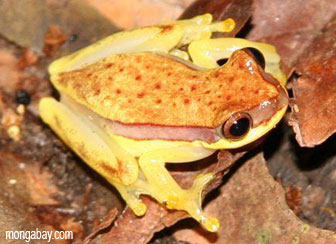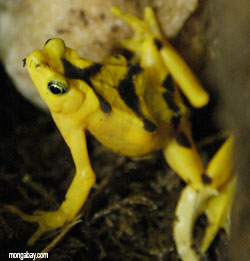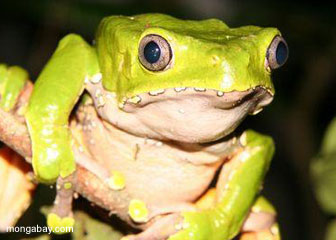“Ark” aims to save amphibians from extinction
“Ark” aims to save amphibians from extinction
mongabay.com
February 15, 2007
Scientists are meeting in Atlanta is discuss last minute efforts to save disappearing amphibians from extinction. A mysterious outbreak of fungal disease has wiped out an estimated 170 species in the past decade, and put more than one-third of the world’s remaining amphibians at risk.
The group, calling itself Amphibian Ark, aims to save threatened amphibians by asking zoos, aquariums, and botanical gardens to act as sanctuaries for disappearing frogs, salamanders, newts, and caecilians. These facilities would serve as a proverbial “ark” to protect amphibians until scientists figure out a way to stop the killer chytrid fungus. While such efforts are already under way with a handful of species at the Bronx Zoo in New York (Kihansi Spray Toad) and the Houston Zoo (Panamanian Golden Frog), the expanded effort for hundreds of species is expected to cost $400-500 million. Organizers are preparing to launch a massive fundraising campaign to create an endowment.

More pictures of frogs |
Scientists don’t yet know the origin of the fungus, though they suspect that it might be the African clawed frog, a species that has been shipped around the world for research purposes. The fungus is highly transmissible and some have accused scientists of inadvertently introducing spores of the pathogen into ecosystems in the tread of their boots. In any case the fungus is now found on at least four continents and is spreading fast. Last month, Japan confirmed the first local frog deaths from the fungus, while in Panama, the fungus appears to be migrating at a steady rate across the isthmus.
Climate Change
Some scientists have argued that global warming could be worsening the crisis. In January 2006, a team of researchers writing in Nature linked climate change to frog extinctions caused by the skin fungus. Led by J. Alan Pounds of the Tropical Science Center’s Monteverde Cloud Forest Preserve in Costa Rica, the scientists focused on the brightly colored harlequin frogs (Atelopus) which are critically endangered across their range—between the 1980s and 1990s, almost two-thirds of the 110 known harlequin frog species went extinct with the chytrid fungus the leading suspect.

Panama’s golden frog (Atelopus zetecki). Unlike other frogs, the Panama golden frog lacks eardrums and communicates by waving its hands. In many parts of Panama this frog is considered a good luck charm and people collect it from the wild to put in their homes. This custom further threatens a species already suffering from the killer chytrid fungus (Batrachochytrium dendrobatidis), an infectious skin disease now found in frog populations around the world. |
Using records of sea-surface and air temperatures, the researchers discovered strong correlations between changes in climate and the last known sightings of the frogs. According to the scientists, the Earth’s rising temperatures enhance cloud cover on tropical mountains, leading to cooler days and warmer nights, both of which favor the chytrid fungus which grows and reproduces best at temperatures between 63 to 77 degrees Fahrenheit (17 to 25 degrees Celsius).
The fungus kills frogs mostly in cool highlands or during winter, implying that low temperatures make it more deadly. Thus the disease flourishes in warm years and puts frogs living at mid-altitudes at greatest risk.
In coming years, further changes in climate change will likely produce conditions more favorable for the fungus and detrimental to frogs and other amphibians.
“Disease is the bullet that’s killing the frogs,” said J. Alan Pounds, at the time when the study was published. “But climate change is pulling the trigger. Global warming is wreaking havoc on amphibians, and soon will cause staggering losses of biodiversity,” he said.
 Monkey frog in Peru (photo by Rhett A. Butler). Scientists are particularly concerned about the global decline of amphibians over the past 20 years. Recent research suggests that the amphibian crisis is tied to global warming. |
“The good news, if there is any, is the new findings will open up avenues of research that could provide scientists with the means to save the amphibians that still survive,” said Bruce Young, a zoologist at NatureServe who took part in the study. “If this cloud has any silver lining, that’s it.”
Ecologists fear that the global decline of amphibians may have broader implications for the world’s environment. Because amphibians have highly permeable skin and spend a portion of their life in water and on land, they are sensitive to environmental change and can act as the proverbial “canary in a coal mine,” indicating the relative health of an ecosystem. As they die, scientists are left wondering what plant or animal group is next.
The disappearance of amphibians is troubling on other grounds as well. Many frogs and toads secrete toxic alkaloids to protect themselves from predators. These alkaloids have been found to have medical applications as pain killers. Thus the loss of each amphibian species eliminates the possibility of finding compounds with potential curative properties.
In 2005 the Global Amphibian Assessment, a survey of the planet’s amphibian species, found that nearly a third (32%) of the world’s 5743 known amphibian species are threatened and 129 species have gone extinct since 1980. Among the species to disappear is Costa Rica’s Golden toad (Bufo periglenes) and the Gastric Brooding Frog (Rheobatrachus silus) of Queensland, Australia. Scientists believe there may be around 10,000 amphibian species on the planet, although this number is likely declining.
Amphibian crisis articles
$400-Million Initiative Proposed to Address Amphibian Crisis. The world’s leading amphibian experts are calling for dramatic steps, including the formation of an Amphibian Survival Alliance (ASA), to prevent the massive extinction of amphibians worldwide. The proposal is set forth in the current issue of the journal Science.
Toad on brink of extinction, scientists race to study amphibian for bioactive compounds. Under the bright florescent lights of the reptile house in the Bronx Zoo of New York, a colorful exotic toad makes its final stand. Once gathering by the thousands at the waterfalls of the Kihansi Gorge of Tanzania, the population of the Kihansi Spray Toad now stands at less than 200 individuals. The hasty construction of a desperately needed dam, built with good intentions by the World Bank, has relegated this species to the edge of existence. A decade ago the Kihansi Spray Toad thrived in its thoroughly unique habitat, the waterfalls of the Kihansi River, part of ecosystem that is one of only 25 Global Biodiversity Hotspots on the planet (Hotspots are regions noted for their extensive range of species in a very small area). The gorge is located in the Southern Udzungwa Mountains of South Central Tanzania, which possess the greatest biodiversity in all of Tanzania.
Pesticides threaten cloud forests in Costa Rica – new study. Pesticides from coffee and banana cultivation are accumulating in Costa Rica’s biodiverse cloud forests according to research published earlier this month in Environmental Science & Technology (ES&T). The findings have implications for conservation efforts in both the Central American country and in other parts of the world.














